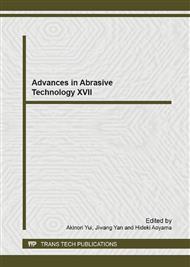p.160
p.166
p.175
p.181
p.187
p.193
p.199
p.205
p.212
A Three-Dimensional Fractal Analysis Method for Ground Monocrystal Sapphire Surface
Abstract:
Conventional characterization methods of grinding surface using surface roughness parameters, e.g., Ra, depend on either the resolution of the measuring instrument or the length of the sample. But fractal dimension (FD) as a scale-independent fractal parameter is effective to evaluate the ground surface at any length scale and represent lots of surface phenomenon at its relevant length scales. In this paper, a three-dimensional (3D) box-counting fractal analysis method is used to investigate ground surface morphology of monocrystal sapphire by calculating 3D fractal dimension of the ground surface. The results obtained show that fractal dimension decreases with the increasing surface roughness. For the ground surface with higher fractal dimension, its microtopography is more exquisite with minor defects. Once the fractal dimension become smaller, deep cracks and pronounced defects are exhibited in ground surface. Moreover, the ground surface obtained in ductile mode has much higher fractal dimension than that in brittle mode. Therefore, the fractal analysis method has the potential to reveal the ground surface characteristics of monocrystal sapphire.
Info:
Periodical:
Pages:
187-192
Citation:
Online since:
September 2014
Authors:
Keywords:
Price:
Сopyright:
© 2014 Trans Tech Publications Ltd. All Rights Reserved
Share:
Citation:


